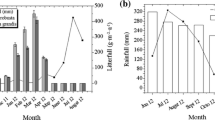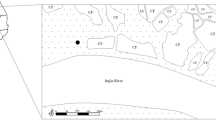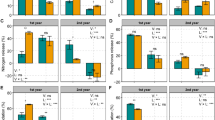Abstract
Annual production of litter by Cistus incanus (L.) and Myrtus communis (L.) and decomposition dynamics of leaf litter of these species was studied in a Mediterranean shrubland. Myrtus and Cistus produced 472 and 429 g dry weight litter m-2 year-1, respectively. Leaves were the predominant litter component for both species. The average decay constant of Myrtus and Cistus litters enclosed in litter bags, calculated over the whole study period (38 months), was 0.71 year-1 and 0.31 year-1 respectively. In green leaves the N content differed during growth seasons for both species, whereas the content of Ca, Mg, P, K, and Na did not show significant changes. Abscised leaves had lower N, P and K contents than green leaves, evidencing that a nutrient translocation before abscission occurred from senescent leaves. The nutrient contents of the leaves at abscission time, generally higher in Cistus than in Myrtus, allowed us to estimate the annual nutrient input to the soil. Phosphorus and K more than N were rapidly released by the decomposing litters after exposure. Nutrient limitation, in particular P, might be considered the main growth limiting factor for Myrtus and Cistus. Both species were adapted to recovery and rapidly recycle P more than N and K in the living biomass through retranslocation from green leaves before abscission and/or a high release rate from the decomposing litter. The former strategy was better used by Cistus, the latter by Myrtus.





Similar content being viewed by others
References
Anderson JM, Ineson P (1984) Interactions between microorganisms and soil invertebrates in nutrient flux pathways of forest ecosystems. In: Anderson JM, Rayner ADM, Walton DWH (eds) Invertebrate-microbial interactions. Cambridge University Press, Cambridge, pp 59–88
Arianoutsou M (1989) Timing of litter production in a maquis ecosystem of North-Eastern Greece. Acta Oecol 10:371–378
Bellot J, Sánchez JR, Lledó MJ, Martínez P, Escarré A (1992) Litterfall as a measure of primary production in Mediterranean Holm-oak forest. Vegetatio 99–100:69–76
Berg B, Calvo de Anta R, Escudero A, Gärdenäs A, Johansson MB, Laskowski R, Madeira M, Mälkönen E, McClaugherty C, Meentmeyer V, Virzo De Santo A (1995) The chemical composition of newly shed needle litter of Scots pine and some other pine species in a climatic transect. Long term decomposition in a Scots pine forest. X. Can J Bot 73:1423–1435
Cuevas E, Medina E (1986) Nutrient dynamics within Amazonian forest ecosystems. I. Nutrient flux in fine litter fall and efficiency of nutrient utilization. Oecologia 68:466–472
Di Nardo C, Papa S, Fuggi A, Fioretto A (2001) Variazioni del contenuto di lignina e cellulosa durante la decomposizione della lettiera in un ecosistema mediterraneo. Proceedings of the XI national congress of the Italian society of ecology, sez 4. Sistemi agroforestali. Italian Society of Ecology
Escudero-Berian A, Garcia B, Gomez-Gutierrez JM, Luis E (1985) The nutrient cycling in Quercus rotundifolia and Q. pirenaica (ecosystems “dehesas” of Spain). Oecol Plant 6:73–86
Esposito A, Strumia S, Buonanno M, Castaldo Cobianchi R, Mazzoleni S (1998) Analysis of bryophyte dynamics after fires of pine woodlands and Mediterranean macchia, Southern Italy. In: Trabaud L (ed) Fire management and landscape ecology. International Association Wildland Fire, Fairfield, Wash., pp 77–85
Facelli JM, Pickett STA (1991) Plant litter: its dynamics and effects on plant community structure. Bot Rev 57:1–32
Finzi AC, Allen AS, De Lucia EH, Ellsworth DS, Schlesinger WH (2001) Forest litter production, chemistry and decomposition following two years of free-air CO2 enrichment. Ecology 82:470–484
Fioretto A, Musacchio A, Andolfi A, Virzo De Santo A (1998) Decomposition dynamics of litters of various pine species in a Corsican pine forest. Soil Biol Biochem 30:721–727
Fioretto A, Papa S, Curcio E, Sorrentino G, Fuggi A (2000) Enzyme dynamics on decomposing leaf litter of Cistus incanus and Myrtus communis in a Mediterranean ecosystem. Soil Biol Biochem 32:1847–1855
Fioretto A, Papa S, Sorrentino G, Fuggi A (2001) Decomposition of Cistus incanus leaf litter in a Mediterranean maquis ecosystem: mass loss, microbial enzyme activities and nutrient changes. Soil Biol Biochem 33:311–321
Gallardo JF, Santa Regina I, San Miguel C (1986) Ritorno al suelo y evolución de la descomposición de la hojarasca en tres ecosistemas forestales de la Sierra de Béjar. In: Diputacio de Barcelona (ed) Bases ecologiques per la gestió ambiental. Diputacio de Barcelona, Barcelona, pp 102–103
Hernandez IM, Gallardo JF, Santa Regina I (1992) Dynamic of organic matter in forests subject to a Mediterranean semi-arid climate in the Duero Basin (Spain): litter production. Acta Oecol 13:55–65
Hubert J, Oyarzun C (1983) Producción de hojarasca y sus relaciones con factores meteorológicos en un bosque de Pinus radiata. Bosque 5:1–11
Jordan CF (1971) A world pattern in plant energetics. Am Sci 59:425–433
Lim MT, Cousens JE (1986) The internal transfer of nutrient in a Scots pine stand. 2. The pattern of transfer and the effects of nitrogen availability. Forestry 59:17–27
Macfayden A (1971) The soil and its total metabolism. In: Philipson J (ed) Methods of study in quantitative soil ecology. IBP handbook no. 18. Blackwell, Oxford, pp 1–13
Maggs J, Pearson CJ (1977) Litter fall and litter layer decay in coastal scrub at Sidney, Australia. Oecologia 31:239–250
Meentemeyer V, Box EO, Thompson R (1982) World patterns and amounts of terrestrial plant litter production. BioScience 32:125–128
Merino J (1986) Productividad. Ciclo de nutrients en el área de Doñana. In: Diputacio de Barcelona (ed) Bases ecologiques per la gestió ambiental. Diputacio de Barcelona, Barcelona, pp 85–89
Miller HG, Cooper JM, Miller JD, Pauline OJL (1979) Nutrient cycles in pine and their adaptation to poor soils. Can J For Res 9:19–26
Núñez-Olivera E, Martínez-Abaigar J, Escudero-García JC (1993) Litterfall and nutrient flux in Cistus ladanifer L. shrubland in S.W. Spain. Acta Oecol 14:361–369
Olson J (1963) Energy storage and balance of producers and decomposers in ecological systems. Ecology 44:322–331
Pausas JG (1997) Litter fall and litter decomposition in Pinus sylvestris forests of the eastern Pyrenees. J Veg Sci 8:643–650
Persson T, Bååth E, Clarholm M, Lundkvist H, Söderström B, Sohlenius B (1980) Trophic structure, biomass dynamics and carbon metabolism of soil organisms in a Scots pine forest. Ecol Bull 32:419–462
Rutigliano FA, Virzo De Santo A, Berg B, Alfani A, Fioretto A (1996) Lignin decomposition in decaying leaves of Fagus sylvatica L. and needles of Abies alba Mill. Soil Biol Biochem 28:101–106
Santa Regina I, Tarazona T (2001) Nutrient pools to the soil through organic matter and throughfall under Scots pine plantation in the Sierra de la Demanda, Spain. Eur J Soil Biol 37:125–133
Santa Regina I, Rico M, Rapp M, Gallego HA (1997) Seasonal variation in nutrient concentration in leaves and branches of Quercus pyrenaica. J Veg Sci 8:651–654
Schlesinger WH, Hasey MM (1981) Decomposition of chaparral shrub foliage: losses of organic and inorganic constituents from deciduous and evergreen leaves. Ecology 62:762–774
Stark NM, Jordan CF (1978) Nutrient retention by the root mat of an Amazonian rain forest. Ecol Durham 59:434–437
Swift MJ, Heal OW, Anderson JM (1979) Decomposition in terrestrial ecosystems. Blackwell Scientific, Oxford
Virzo De Santo A, Berg B, Rutigliano FA, Alfani A, Fioretto A (1993) Factors regulating early-stage decomposition of needle litter in five different coniferous forests. Soil Biol Biochem 25:1423–1433
Vitousek PM (1982) Nutrient cycling and nutrient-use efficiency. Am Nat 119:553–572
Vogt KA, Grier CC, Vogt DJ (1986) Production, turnover and nutrient dynamics of above- and belowground detritus of world forests. Adv Ecol Res 15:303–370
Weber M (1987) Decomposition, litter fall, and forest floor nutrient dynamics in relation to fire in eastern Ontario jack pine ecosystems. Can J For Res 17:1496–1506
Acknowledgements
The research was supported by MURST (Ministero dell’Università e Ricerca Scientifica of Italy) and by ModMed2 project contract no. ENV45T950139 and ModMed3 project contract no. ENV4CT970680 (European Community). Thanks to Dr. N. Costantino, who permitted us to work in the Natural Reserve of Castel Volturno and to the warrant officer, N. Ricciardi and the staff of the “Ispettorato della Forestale di Castel Volturno” for their help. Thanks also to Dr G. Bartoli for help in nutrient analyses.
Author information
Authors and Affiliations
Corresponding author
Rights and permissions
About this article
Cite this article
Fioretto, A., Papa, S. & Fuggi, A. Litter-fall and litter decomposition in a low Mediterranean shrubland. Biol Fertil Soils 39, 37–44 (2003). https://doi.org/10.1007/s00374-003-0675-5
Received:
Accepted:
Published:
Issue Date:
DOI: https://doi.org/10.1007/s00374-003-0675-5




